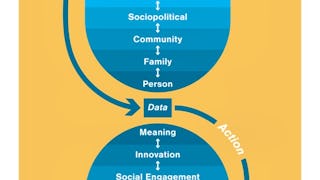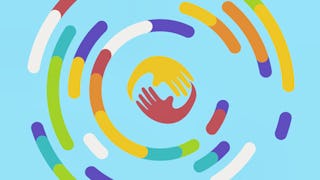This fourth of five courses examines the methodological approaches and research tools that inform our understanding of best practices in working with science teams, communities, and with data. The topics of this course include:


Social Determinants of Health: Methodological Opportunities
包含在  中
中
您将获得的技能
要了解的详细信息
了解顶级公司的员工如何掌握热门技能

积累特定领域的专业知识
- 向行业专家学习新概念
- 获得对主题或工具的基础理解
- 通过实践项目培养工作相关技能
- 获得可共享的职业证书

该课程共有5个模块
The purpose of this module is to examine community-based participatory research (CBPR) and evaluate its potential applications in data-to-action initiatives. Lesson one will define CBPR, as we discuss its origin and relation to collective impact. We will also review the goals, purpose, benefits and characteristics of CBPR as we compare it to traditional research methods. In lesson two, we will explore potential measurement strategies for analyzing CBPR outcomes and data-to-action interventions. We will also consider how CBPR success is measured and how data can be used to amplify community voices.
涵盖的内容
3个视频4篇阅读材料2个作业1个讨论话题5个插件
This module will introduce the principles of team science and examine how team science can be used to enhance data-to-action initiatives. In lesson one, we will define team science, as we discuss how it is related to collective impact and CBPR. We will also review recommendations made by the National Academies Committee on the Science of Team Science for improving team science effectiveness. Lesson two will focus on the opportunities and challenges for team science in communities, as we further discuss incorporating community perspectives into team science research. We will also evaluate how to measure team science outcomes, as we consider how team science can add perspective and voice to data.
涵盖的内容
2个视频4篇阅读材料2个作业1个讨论话题3个插件
This module will focus on the importance of community partnerships in collecting and analyzing community-level data that can be integrated into data-to-action initiatives. Lesson one will define key terms, and introduce the concept of whole-person health. We will also explore how community data can be used to advocate, influence and create policy to support health equity. In lesson two, we will examine the use of simplified plain language in the context of health literacy, as we discuss how to assess the usability of community-validated plain language terms. Lesson three will introduce the MyStrengths+MyHealth assessment, as we review the implications of collecting community-based social determinant of health data. Finally in lesson four, we will evaluate a community-level data exemplar, as we consider how to translate whole person health and community-level data into community-driven health initiatives.
涵盖的内容
5个视频8篇阅读材料2个作业1个讨论话题
In this module, we will examine informatics as a potential methodology and resource to inform data-to-action initiatives. Lesson one will define key concepts including informatics, knowledge complexity, and knowledge management. Building on these concepts, we will investigate the levels of knowledge management proposed by Verna Allee. We will also consider the different perspectives on the proposed creation of a new social informatics specialty. Building on our understanding of knowledge management, in lesson two, we will explore knowledge representation structures. We will also analyze the use of publicly available population health records as contextual information to manage knowledge and data for action to reduce health disparities. In addition, we will evaluate knowledge representation structures of evidence-based social determinants of health interventions. Finally, we will explore some informatics applications including the Population Health Record and the WHO Health Equity Assessment Toolkit (HEAT).
涵盖的内容
2个视频4篇阅读材料2个作业1个讨论话题3个插件
This module will focus on analyzing, displaying and interpreting social determinants of health data, with a particular focus on comparing health outcomes by groups. Lesson one will provide an overview of ANOVA analysis and line graph visualization. In lesson two, we will learn how to conduct ANOVA analyses and create line graphs in R. Using the NHANES dataset, we will compare the mean Hgb a1c by education level. Using the Omaha System dataset, we will compare the mean change in status by number of problems. Finally, we will discuss how to interpret the results of our analysis as we visualize our findings using line graphs.
涵盖的内容
2个视频4篇阅读材料1次同伴评审1个讨论话题1个非评分实验室3个插件
获得职业证书
将此证书添加到您的 LinkedIn 个人资料、简历或履历中。在社交媒体和绩效考核中分享。
位教师


从 Health Informatics 浏览更多内容
 状态:免费试用
状态:免费试用University of Minnesota
 状态:免费试用
状态:免费试用University of Minnesota
 状态:免费试用
状态:免费试用University of Michigan
 状态:免费试用
状态:免费试用University of Michigan
人们为什么选择 Coursera 来帮助自己实现职业发展




常见问题
To access the course materials, assignments and to earn a Certificate, you will need to purchase the Certificate experience when you enroll in a course. You can try a Free Trial instead, or apply for Financial Aid. The course may offer 'Full Course, No Certificate' instead. This option lets you see all course materials, submit required assessments, and get a final grade. This also means that you will not be able to purchase a Certificate experience.
When you enroll in the course, you get access to all of the courses in the Specialization, and you earn a certificate when you complete the work. Your electronic Certificate will be added to your Accomplishments page - from there, you can print your Certificate or add it to your LinkedIn profile.
Yes. In select learning programs, you can apply for financial aid or a scholarship if you can’t afford the enrollment fee. If fin aid or scholarship is available for your learning program selection, you’ll find a link to apply on the description page.
更多问题
提供助学金,
¹ 本课程的部分作业采用 AI 评分。对于这些作业,将根据 Coursera 隐私声明使用您的数据。




